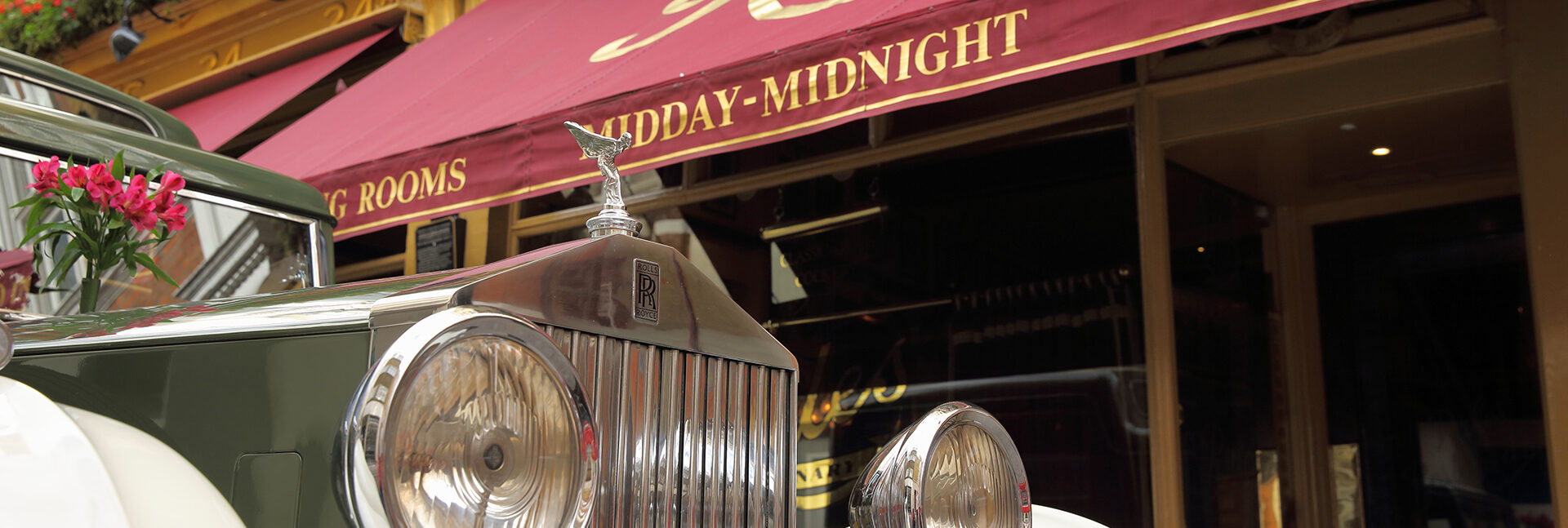History
History of London's oldest Restaurant
Rules still flourishes, the oldest restaurant in London and one of the most celebrated in the world.
In over 200 years, spanning the reigns of nine monarchs, it has been owned by only three families . . . just before The Great War, Charles Rule, a descendant of the founder, was thinking of moving to Paris; by sheer coincidence he met Tom Bell, a Briton who owned a Parisian restaurant called the Alhambra, and the two men decided to swap businesses. (During the war Tom Bell was an officer in the Royal Flying Corps, and left the running of the restaurant to Charlie, the Head Waiter, who had served Charles Rule for many years.) During the second world war, Rules stayed open but its structure was reinforced with thick wood. It was only open from 1pm to 3pm and offered the compulsory rationed meals at five shillings but could offer copious rabbits, grouse and pheasants which were not rationed. A lady was the Head Waiter during the war. The restaurant could never open on Sundays because it was on Church grounds and could not get a licence.
In 1984 Tom Bell’s daughter sold Rules to John Mayhew, the present owner. Today Rules seats around 90 people and employs 90 staff.
Rules serves the traditional food of this country at its best – and at affordable prices. It specialises in classic game cookery, oysters, pies and puddings.
From Simon Pembroke, Fellow of Kings College, Cambridge with a Double First from Cambridge University and unusually a Distinction in Ancient History.
“I am now quite certain in my own mind that the proposition that Thomas Rule gained some kind of foothold at Maiden Lane in 1798 (in the oyster line) is unassailable. He never paid the rates, but only one person per building was a ratepayer (not ‘dwelling’ – there were as many as three separate households an incredible total of 30 person recorded in the Census of 1841, which is the first year for which we have these details). The census was instituted in 1801 and took place every ten years, although individuals are not named until 1841. But we do know who did, and that for various reasons they were equivocal about the real nature of their activities and livelihoods. I see Thomas paving the way for his son Benjamin, who quite certainly turns up (as ratepayer, shell fishmonger, and newlywed) in 1828. You may also recall that in the Minories (Fountain Court), William (elder brother of Thomas) first turns up with Thomas next door, both paying Land Tax for the year 1799. Benjamin Rule, son of Thomas Rule, signs a 30 year lease on 10th April 1848 for No 36 Maiden Lane with The Most Noble, Francis Duke of Bedford, Knight of the Most Noble Order of the Garter at a rent of £50 per annum. The first time individuals are named on any census for London shows Benjamin Rule at No 38 paying Rates at £5.13s.9d. in 1828.
Prior to this date, William was already ensconced in ‘Little George Street’ (later and now = Vine Street, parallel with but to the West of Minories), married and with child. All this lends weight to the restaurant tradition that when Black Sheep Thomas was made to get his mind right by brother William in Fountain Court (from which he ventured forth to the West End, as we know Joseph Sheekey did 100 years later from Billingsgate) it was under the heavy hand of brother William. Some further evidence about Willaim’s neighbour (Mrs) Ann Green, together with whom he dissapears from sight in 1817, and an almost certain connection with Benjamin’s future wife Hannah Green, who in a later Census record (1851) reveals herself as hailing from ‘Dangee’ = Dengie in Essex on the River Blackwater = Oyster Country.”
Some History of Maiden Lane.
“The painter, J.M.W. Turner, was born on the site of what is now No.21, then his father’s barber’s shop; and the metaphysical poet, Andrew Marvell, lodged at No.9 in 1677. His father, Andrew Marvell senior, had expired thirty-six years earlier under curious circumstances. He had no sooner embarked on a ferry and uttered a cheery: ‘Ho, for heaven!’, than the boat sank.
Maiden Lane forms part of an ancient track which linked the convent garden of the monks of Westminster Abbey to St.Martin’s Lane. Houses began to go up along its boundaries about 1630, although none of the originals survive. Until 1857 it was a cul-de-sac linked to Southampton Street by a footpath. Then a way through was made so that Queen Victoria’s carriage did not have to turn round after dropping her at the Adelphi Theatre.
This allegorical and romantic oil painting by John Springs commissioned for the restaurant has ex-Prime Minister, Margaret Thatcher, standing triumphant – all big-haired and blue-eyed – with the Falkland Islands in the background. Click on the image for a bigger picture. To contact the artist go to: www.johnsprings.com


